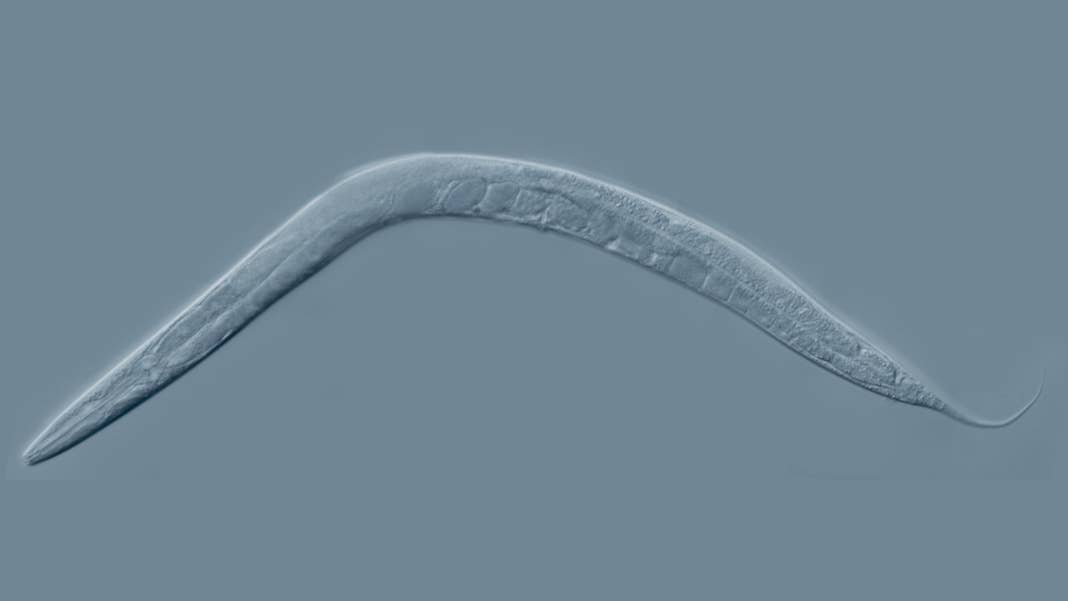Scientists Merge Biology and Technology by 3D Printing Electronics Inside Living Worms

Share
Finding ways to integrate electronics into living tissue could be crucial for everything from brain implants to new medical technologies. A new approach has shown that it’s possible to 3D print circuits into living worms.
There has been growing interest in finding ways to more closely integrate technology with the human body, in particular when it comes to interfacing electronics with the nervous system. This will be crucial for future brain-machine interfaces and could also be used to treat a host of neurological conditions.
But for the most part, it’s proven difficult to make these kinds of connections in ways that are non-invasive, long-lasting, and effective. The rigid nature of standard electronics means they don’t mix well with the squishy world of biology, and getting them inside the body in the first place can require risky surgical procedures.
A new approach relies instead on laser-based 3D printing to grow flexible, conductive wires inside the body. In a recent paper in Advanced Materials Technologies, researchers showed they could use the approach to produce star- and square-shaped structures inside the bodies of microscopic worms.
“Hypothetically, it will be possible to print quite deep inside the tissue,” John Hardy at Lancaster University, who led the study, told New Scientist. “So, in principle, with a human or other larger organism, you could print around 10 centimeters in.”
The researchers’ approach involves a high-resolution Nanoscribe 3D printer, which fires out an infrared laser that can cure a variety of light-sensitive materials with very high precision. They also created a bespoke ink that includes the conducting polymer polypyrrole, which previous research had shown could be used to electrically stimulate cells in living animals.
To prove the scheme could achieve the primary goal of interfacing with living cells, the researchers first printed circuits into a polymer scaffold and then placed the scaffold on top of a slice of mouse brain tissue being kept alive in a petri dish. They then passed a current through the flexible electronic circuit and showed that it produced the expected response in the mouse brain cells.
The team then decided to demonstrate the approach could be used to print conductive circuits inside a living creature, something that had so far not been achieved. The researchers decided to use the roundworm C. elegans due to its sensitivity to heat, injury, and drying out, which they said would make for a stringent test of how safe the approach is.
Be Part of the Future
Sign up to receive top stories about groundbreaking technologies and visionary thinkers from SingularityHub.


First, the team had to adjust their ink to make sure it wasn’t toxic to the animals. They then had to get it inside the worms by mixing it with the bacterial paste they’re fed on.
Once the animals had ingested the ink, they were placed under the Nanoscribe printer, which was used to create square and star shapes a few micrometers across on the worms’ skin and within their guts. The shapes didn’t come out properly in the moving gut though, the researchers admit, due to the fact it was constantly moving.
The shapes printed inside the worms’ bodies had no functionality. But Ivan Minev from the University of Sheffield told New Scientist the approach could one day make it possible to build electronics intertwined with living tissue, though it would still take considerable work before it was applicable in humans.
The authors also admit that adapting the approach for biomedical applications would require significant further research. But in the long run, they believe their work could enable tailor-made brain-machine interfaces for medical purposes, future neuromodulation implants, and virtual reality systems. It could also make it possible to easily repair bioelectronic implants within the body.
All that’s likely still a long way from being realized, but the approach shows the potential of combining 3D printing with flexible, biocompatible electronics to help interface the worlds of biology and technology.
Image Credit: Kbradnam/Wikimedia Commons
Related Articles

How Scientists Are Growing Computers From Human Brain Cells—and Why They Want to Keep Doing It

These Brain Implants Are Smaller Than Cells and Can Be Injected Into Veins

This Wireless Brain Implant Is Smaller Than a Grain of Salt
What we’re reading
